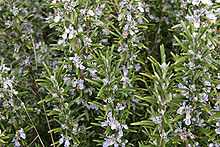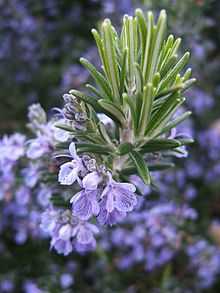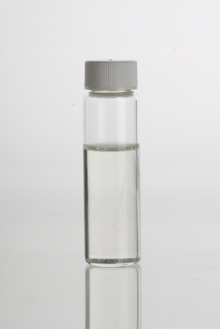Rosemary
| Rosmarinus officinalis Rosemary | |
|---|---|
 | |
| Rosemary in flower | |
| Scientific classification | |
| Kingdom: | Plantae |
| (unranked): | Angiosperms |
| (unranked): | Eudicots |
| (unranked): | Asterids |
| Order: | Lamiales |
| Family: | Lamiaceae |
| Genus: | Rosmarinus |
| Species: | R. officinalis |
| Binomial name | |
| Rosmarinus officinalis L.[1] | |
Rosmarinus officinalis, commonly known as rosemary, is a woody, perennial herb with fragrant, evergreen, needle-like leaves and white, pink, purple, or blue flowers, native to the Mediterranean region. It is a member of the mint family Lamiaceae, which includes many other herbs. The name "rosemary" derives from the Latin for "dew" (ros) and "sea" (marinus), or "dew of the sea".[2] The plant is also sometimes called anthos, from the ancient Greek word ἄνθος, meaning "flower".[3]
Taxonomy
Rosmarinus officinalis is one of 2-4 species in the genus Rosmarinus'.[4] The other species most often recognized is the closely related, Rosmarinus eriocalyx, of the Maghreb of Africa and Iberia. The genus was named by the 18th-century naturalist and founding taxonomist Carolus Linnaeus.
Description



Rosemary is an aromatic evergreen shrub that has leaves similar to hemlock needles. The leaves are used as a flavoring in foods such as stuffings and roast lamb, pork, chicken and turkey. It is native to the Mediterranean and Asia, but is reasonably hardy in cool climates. It can withstand droughts, surviving a severe lack of water for lengthy periods.[5] Forms range from upright to trailing; the upright forms can reach 1.5 m (5 ft) tall, rarely 2 m (6 ft 7 in). The leaves are evergreen, 2–4 cm (0.8–1.6 in) long and 2–5 mm broad, green above, and white below, with dense, short, woolly hair. The plant flowers in spring and summer in temperate climates, but the plants can be in constant bloom in warm climates; flowers are white, pink, purple or deep blue.[6]
Mythology
According to legend, it was draped around the Greek goddess Aphrodite when she rose from the sea, born of Uranus's semen. The Virgin Mary is said to have spread her blue cloak over a white-blossomed rosemary bush when she was resting, and the flowers turned blue. The shrub then became known as the 'Rose of Mary'.[7]
Usage
Rosemary is used as a decorative plant in gardens and has many culinary and medical uses. The plant is said to improve the memory. The leaves are used to flavor various foods, such as stuffings and roast meats.
Cultivation
Since it is attractive and drought tolerant, rosemary is used as an ornamental plant in gardens and for xeriscape landscaping, especially in regions of Mediterranean climate. It is considered easy to grow and pest-resistant. Rosemary can grow quite large and retain attractiveness for many years, can be pruned into formal shapes and low hedges, and has been used for topiary. It is easily grown in pots. The groundcover cultivars spread widely, with a dense and durable texture.
Rosemary grows on friable loam soil with good drainage in an open, sunny position. It will not withstand waterlogging and some varieties are susceptible to frost. It grows best in neutral to alkaline conditions (pH 7–7.8) with average fertility. It can be propagated from an existing plant by clipping a shoot (from a soft new growth) 10–15 cm (4–6 in) long, stripping a few leaves from the bottom, and planting it directly into soil.
Cultivars
Numerous cultivars have been selected for garden use. The following are frequently sold:
- 'Albus' – white flowers
- 'Arp' – leaves light green, lemon-scented
- 'Aureus' – leaves speckled yellow
- 'Benenden Blue' – leaves narrow, dark green
- 'Blue Boy' – dwarf, small leaves
- 'Golden Rain' – leaves green, with yellow streaks
- 'Gold Dust' -dark green leaves, with golden streaks but stronger than 'Golden Rain'
- 'Irene' – low and lax, trailing, intense blue flowers
- 'Lockwood de Forest' – procumbent selection from 'Tuscan Blue'
- 'Ken Taylor' – shrubby
- 'Majorica Pink' – pink flowers
- 'Miss Jessop's Upright' – distinctive tall fastigiate form, with wider leaves.
- 'Pinkie' – pink flowers
- 'Prostratus' - lower groundcover
- 'Pyramidalis' (or 'Erectus') – fastigate form, pale blue flowers
- 'Remembrance' (or 'Gallipoli') - taken from the Gallipoli Peninsula[8]
- 'Roseus' – pink flowers
- 'Salem' – pale blue flowers, cold hardy similar to 'Arp'
- 'Severn Sea' – spreading, low-growing, with arching branches, flowers deep violet
- 'Tuscan Blue' – traditional robust upright form
- 'Wilma's Gold' – yellow leaves
The following cultivars have gained the Royal Horticultural Society's Award of Garden Merit:-
Culinary use
The leaves, both fresh and dried, are used in traditional Italian cuisine. They have a bitter, astringent taste and are highly aromatic, which complements a wide variety of foods. A tisane can be made from the leaves. When burnt, they give off a mustard-like smell and a smell similar to burning wood, which can be used to flavor foods while barbecuing. Rosemary is high in iron, calcium and vitamin B6,[13] 317 mg, 6.65 mg and 0.336 mg per 100 g, respectively.[14] Rosemary extract has been shown to improve the shelf life and heat stability of omega 3-rich oils, which are prone to rancidity.[15]

Fragrance

Rosemary oil is used for purposes of fragrant bodily perfumes or to emit an aroma into a room. It is also burnt as incense, and used in shampoos and cleaning products.[16]
Traditional medicine
Hungary water was first prepared for the Queen of Hungary Elisabeth of Poland to " ... renovate vitality of paralyzed limbs ... " and to treat gout. It was used externally and prepared by mixing fresh rosemary tops into spirits of wine.[17] Don Quixote (Part One, Chapter XVII) mixes it in his recipe of the miraculous balm of Fierabras.[18]
Rosemary has a very old reputation for improving memory and has been used as a symbol for remembrance during weddings, war commemorations and funerals in Europe and Australia.[19] Mourners would throw it into graves as a symbol of remembrance for the dead. In Shakespeare's Hamlet, Ophelia says, "There's rosemary, that's for remembrance." (Hamlet, iv. 5.)
Rosemary contains a number of potentially biologically active compounds, including antioxidants carnosic acid and rosmarinic acid. Other chemical compounds include camphor, caffeic acid, ursolic acid, betulinic acid, rosmaridiphenol and rosmanol. Rosemary antioxidants levels are closely related to soil moisture content.[20]
Cosmetic use
Rosemary is used as antiseptic and anticellulite.
Folklore and customs
In the Middle Ages, rosemary was associated with wedding ceremonies. The bride would wear a rosemary headpiece and the groom and wedding guests would all wear a sprig of rosemary, and from this association with weddings, rosemary evolved into a love charm. Newlywed couples would plant a branch of rosemary on their wedding day. If the branch grew, it was a good omen for the union and family. In ‘A Modern Herbal’, Mrs Grieves says, “A rosemary branch, richly gilded and tied with silken ribands of all colours, was also presented to wedding guests, as a symbol of love and loyalty.” If a young person would tap another with a rosemary sprig and if the sprig contained an open flower, it was said that the couple would fall in love.
Rosemary was used as a divinatory herb. Several herbs were grown in pots and assigned the name of a potential lover. They were left to grow and the plant that grew the strongest and fastest gave the answer. Rosemary was stuffed into poppets (cloth dolls) to attract a lover or attract curative vibrations for illness. It was believed that placing a sprig of rosemary under a pillow before sleep would repel nightmares, and if placed outside the home it would repel witches. Somehow, the use of rosemary in the garden to repel witches turned into signification that the woman ruled the household in homes and gardens where rosemary grew abundantly. By the 16th century, men were known to rip up rosemary bushes to show that they, not their wives, ruled the roost.[21]
In Australia, sprigs of rosemary are worn on ANZAC Day and sometimes Remembrance Day to signify remembrance; the herb grows wild on the Gallipoli Peninsula.[19]
References in popular culture
- The song "Scarborough Fair" (popularised by Simon and Garfunkel) has the refrain "Parsley, Sage, Rosemary and Thyme" which is also the title of their third studio album.
- Rosemary & Thyme is the name of a British TV detective series, starring Felicity Kendal and Pam Ferris.
See also
References
- ↑ "Rosmarinus officinalis information from NPGS/GRIN". www.ars-grin.gov. Retrieved 2008-03-03.
- ↑ Room, Adrian (1988). A Dictionary of True Etymologies. Taylor & Francis. p. 150. ISBN 978-0-415-03060-1.
- ↑ "The month." The Pharmaceutical Journal and Transactions: A Weekly Record of Pharmacy and Allied Sciences. Published by the Pharmaceutical Society of Great Britain. April 1887. 804–804
- ↑ Rossello, J.A.; et al. (2006). "Intragenomic diversity and phylogenetic systematics of wild rosemaries (Rosmarinus officinalis L. s.l., Lamiaceae) assessed by nuclear ribosomal DNA sequences (ITS)". Plant Systematics and Evolution 262 (1-2): 1–12. doi:10.1007/s00606-006-0454-5. Retrieved November 11, 2012.
- ↑ "How to grow the herb rosemary". GardenAction. Retrieved 10 November 2011.
- ↑ BHG.com
- ↑ "Rosemary". ANZAC Day Commemoration Committee (Qld) Incorporated. 1988. Retrieved 10 November 2011.
- ↑ http://gardenclinic.com.au/in_the_vegie_patch/rosemary/
- ↑ Rosmarinus officinalis 'Miss Jessop's Upright' AGM
- ↑ Rosmarinus officinalis 'Severn Sea' AGM
- ↑ Rosmarinus officinalis 'Sissinghurst Blue' AGM
- ↑ Rosmarinus officinalis var. angustissimus 'Benenden Blue' AGM
- ↑ "Nutrition Facts - Rosemary".
- ↑ NAL.usda.gov
- ↑ "Oregano, rosemary extracts promise omega-3 preservation". 2007-11-20.
- ↑ "Health Benefits Of Rosemary Oil". organicfacts.net.
- ↑ "Rosemary at SuperbHerbs.net".
- ↑ Capuano, Thomas (2005). "Las huellas de otro texto médico en Don Quijote: Las virtudes del romero". Romance Notes 45 (3): 303–310.
- ↑ 19.0 19.1 "Rosemary". Australian War Memorial. Retrieved 10 November 2011.
- ↑ National Non-Food Crops Centre. NNFCC Project Factsheet: Assessment and Development of the Supply Chain to Deliver Rosemary Antioxidants to the Food and Pharmaceutical Industries (Defra), NF0609
- ↑ "History, Myths and Legends of Aromatherapy - Rosemary".
Further reading
- Calabrese, V.; et al. (2000). "Biochemical studies of a natural antioxidant isolated from rosemary and its application in cosmetic dermatology". International Journal of Tissue Reactions 22 (1): 5–13. PMID 10937349.
- Huang, M. T.; et al. (1 February 1994). "Inhibition of skin tumorigenesis by rosemary and its constituents carnosol and ursolic acid". Cancer Research 54 (3): 701–708. PMID 8306331.
External links
| Wikimedia Commons has media related to Rosmarinus officinalis. |
| Wikispecies has information related to: Rosmarinus officinalis |
| Wikibooks Cookbook has a recipe/module on |
-
 Chisholm, Hugh, ed. (1911). "rosemary". Encyclopædia Britannica (11th ed.). Cambridge University Press
Chisholm, Hugh, ed. (1911). "rosemary". Encyclopædia Britannica (11th ed.). Cambridge University Press - Rosemary List of Chemicals (Dr. Duke's)
- medicinal use: botanical.com
- History of Rosemary
- Description of characteristics, from Flora of China